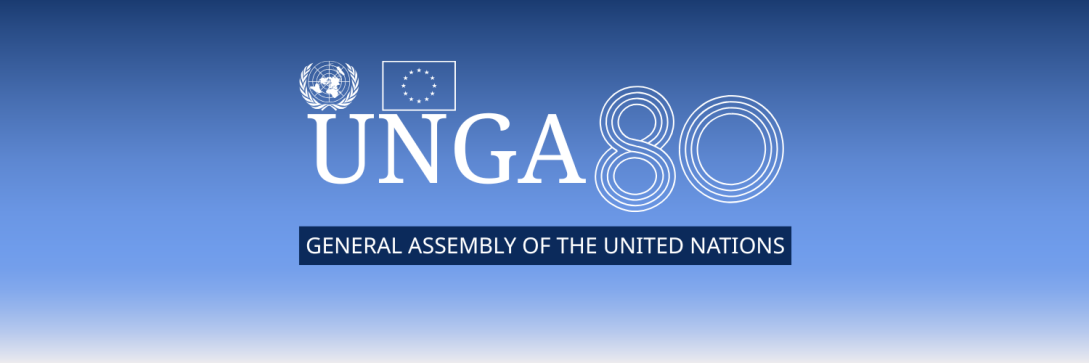Humanitarian Diplomacy: Realising Hope in the Middle East Crises

High-Level Ministerial Side Event: Humanitarian Diplomacy in Action: Collective Response to the Crises in the Middle East
UNGA 80 Restricted Side Event
Background:
Humanitarian crises in the Middle East and Sudan remain among the most complex and severe globally, affecting millions of lives due to armed conflicts. These crises are also fueled by fragility, displacement, instability, and increasingly, climate change. As the region confronts both protracted and emerging crises, there is a pressing need to rethink humanitarian action through principled, inclusive, and future-oriented diplomacy.
Humanitarian diplomacy is a critical tool for navigating these challenges, helping create the relationships that can mobilize political leverage to facilitate access to affected populations, promote adherence to international humanitarian and human rights law, and address other humanitarian priorities.
This event will serve as a platform for international leaders, policymakers and humanitarian stakeholders to engage in dynamic dialogue on the role of humanitarian diplomacy as a catalyst for access, the protection of civilians, and recovery in the Middle East and Sudan. It will focus on how to effectively address the region’s most pressing challenges, including widespread hunger, disruption of essential services, and rising violations of human rights and international humanitarian law through humanitarian diplomacy as a key enabler of solutions. The goal of the event is to strengthen international cooperation toward delivering tangible outcomes for affected populations through actionable humanitarian diplomatic engagement based on common humanitarian goals.
Humanitarian Situation Snapshots:
Occupied Palestinian Territory (OPT): The situation in Gaza has reached its worst point since the latest round of hostilities began in October 2023, driven by intense military operations, relentless displacement orders, rising casualties, shrinking humanitarian space, and a blockade on aid and commercial supplies. Over 83% of Gaza is under evacuation orders or Israeli military control, with severely restricted humanitarian access, and famine is looming. In the West Bank, Israeli operations continue to cause significant destruction and displacement, with increasing settler violence and access restrictions impeding people's access to livelihoods and essential services. Over 56,000 Palestinians have been killed and 130,000 injured in Gaza since October 2023, as of late June 2025, according to the Gaza Ministry of Health. The UN and partners face significant challenges, with over 470 aid workers killed since October 2023. An estimated 3.3 million people are in need in 2025, with 3.0 million targeted for assistance.
Syria: Syria continues to face one of the world's largest humanitarian crises. In 2025, 16.5 million people will need assistance, with 8.3 million prioritized for urgent help. Approximately 13 million people are experiencing acute food insecurity, and around 500,000 children and women require lifesaving nutrition support annually. Access to health services, water, and electricity remains limited or restricted, and intercommunal tensions remain high. The country also faces one of the world's largest displacement crises, with over 7 million internally displaced people (IDPs) and roughly 4.5 million refugees in the region. However, the Humanitarian Response Priorities remain severely underfunded, with only 15 percent of the needs met through June. Funding shortages have caused significant cuts to aid and the closure or scaling down of dozens of health facilities and protection centers. UNHCR projects that 3.5 million Syrians may return to their areas of origin this year. Yet, damaged homes, insufficient services, and unexploded remnants of war continue to be major obstacles to safe and sustainable returns.
Yemen: In 2025, 19.5 million people in Yemen need humanitarian assistance and protection, with 10.5 million targeted. Humanitarian partners continue to face significant challenges in the operational space, including the arbitrary detention of humanitarian personnel, bureaucratic impediments, restrictions on aid worker movement, interference in activities, and threats to personnel and assets.
Sudan: The humanitarian situation in Sudan continues to deteriorate as the conflict enters its third year. The harm inflicted on civilians across the country continues to escalate, resulting in numerous deaths and injuries, while ongoing hostilities drive further displacement. Famine has been confirmed in at least five locations, and displacement reaches record levels, despite some returns. Cholera and other diseases are spreading. In 2025, a record 30.4 million people need humanitarian aid, with 20.9 million targeted. Access remains a fundamental challenge, constrained by conflict, insecurity, bureaucratic and administrative impediments, and interference. The operation requires $4.2 billion to support 21 million people but faces significant funding gaps.
Objectives
1. Enhance strategic partnerships to improve humanitarian access and action through diplomatic engagement, ensuring the full, safe, timely, and unhindered delivery of assistance in accordance with international humanitarian law.
2. Mobilise Collective Political Support from the international community to address operational challenges affecting the humanitarian response, including administrative and bureaucratic impediments and the protection of aid workers.
3. Secure sustainable and flexible funding to enable a principled, needs-based humanitarian response to meet urgent needs, particularly through pooled and unearmarked funding.
4. Support the multilateral humanitarian system by fostering a coordinated, inclusive and effective response in complex crisis settings.
PRACTICAL INFORMATION
Restricted entry - this event will also be livestreamed via UN WebTV
